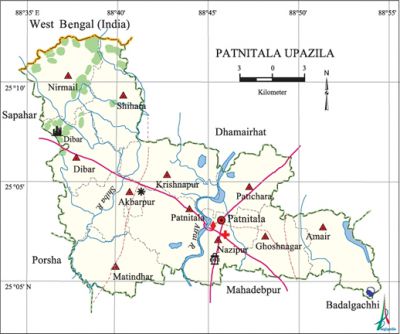Patnitala Upazila
Patnitala Upazila (naogaon district) area 382.39 sq km, located in between 24°59' and 25°12' north latitudes and in between 88°35' and 88°55' east longitudes. It is bounded by dhamoirhat upazila and west bengal state of India on the north, mahadebpur upazila on the south, badalgachhi upazila on the east, sapahar and porsha upazilas on the west.
Population Total 209440; male 108529, female 100911; Muslim 163453, Hindu 30830, Buddhist 3641, Christian 43 and others 11473. Indigenous communities such as santal, oraon, Mahali and munda belong to this upazila.
Water bodies Main rivers: atrai, shiba.
Administration Patnitala Thana was formed in 1907 and it was turned into an upazila in 1983.
| Upazila | ||||||||
| Municipality | Union | Mouza | Village | Population | Density (per sq km) | Literacy rate (%) | ||
| Urban | Rural | Urban | Rural | |||||
|
1 |
11 |
297 |
292 |
16929 |
192511 |
548 |
64.7 |
48.4 |
| Municipality | ||||||||
|
Area (sq km) |
Ward |
Mahalla |
Population |
Density (per sq km) |
Literacy rate (%) | |||
|
11.82 |
9 |
14 |
16929 |
1432 |
64.66 | |||
| Union | ||||
| Name of union and GO code | Area (acre) | Population | Literacy rate (%) | |
| Male | Female | |||
|
Akbarpur 12 |
8317 |
10054 |
9454 |
47.06 |
|
Amair 17 |
8413 |
10074 |
9409 |
42.70 |
|
Krishnapur 43 |
10233 |
10754 |
10250 |
44.93 |
|
Ghoshnagar 34 |
7572 |
10585 |
9881 |
53.49 |
|
Dibar 25 |
7787 |
7816 |
7329 |
48.84 |
|
Nazipur 60 |
7589 |
5719 |
5326 |
51.07 |
|
Nirmail 69 |
9093 |
6515 |
6160 |
50.88 |
|
Patnitala 86 |
8915 |
9877 |
9577 |
45.74 |
|
Patichara 77 |
7899 |
9613 |
8606 |
52.63 |
|
Matindhar 51 |
8742 |
9417 |
8789 |
48.14 |
|
Shihara 94 |
9155 |
9008 |
8298 |
49.34 |
Source Bangladesh Population Census 2001,Bangladesh Bureau of Statistics.

Archaeological heritage and relics Dibar Dighi and Vhimer Panyhi (1075), Victory Pillar of Raja Divyak, Amair Dighi, 'Kangan Dighi and Jogir Ghopa are notable.
Religious institutions Mosque 336, temple 147, church 9, sacred place 1.
Literacy rate and educational institutions Average literacy 49.8%; male 53.1%, female 46.3%. Educational institutions: college 4, primary school 122, madrasa 28. Noted educational institutions: Nazipur Government College (1973), Nazipur Mohila College (1995), Katabari High School (1924), Nazipur Pilot High School (1930), Sarlabala (Gandhi) Girls' School (1920), Nazipur Siddiqia Fazil Madrasa (1969).
Cultural organisations Library 1, club 24, theatre group 2, cinema hall 4, women's organisation 1, playground 6.
Main sources of income Agriculture 80.24%, non-agricultural labourer 2.07%, industry 0.70%, commerce 7.75%, transport and communication 2.05%, service 3.64%, construction 0.41%, religious service 0.14%, rent and remittance 0.06% and others 2.94%.
Main crops Paddy, wheat, potato, sugarcane, onion, vegetables.
Extinct or nearly extinct crops Aus paddy, barley, tobacco.
Main fruits Mango, jackfruit, banana, litchi, watermelon.
Fisheries, dairies and poultries Fishery 5, dairy 4, poultry 30, hatchery 2.
Communication facilities Pucca road 35.66 km, semi-pucca road 480 km, mud road 418.27 km.
Extinct or nearly extinct traditional transport Palanquin, dhuli, horse carriage, bullock cart.
Noted manufactories Flour mill, rice mill, ice factory, biscuit factory.
Cottage industries Goldsmith, blacksmith, potteries, bamboo work, wood work.
Hats, bazars and fairs Hats and bazars are 29, fairs 12, most noted of which are Madhail Hat, Shibpur Hat, Nazipur Hat, Chaitra Samkranti Mela at Trimohani, Baruni Snan Mela, Kashipur Mela, Padmapukur Mela, Jatnipatni Mela.
Main exports Molasses, paddy, rice, watermelon.
Access to electricity All the wards and unions of the upazila are under electrification net-work. However 8.76% of the dwelling households have access to electricity.
Natural resources Zinc mine (Ambati), lime stone (Chawknirkhin) and China mati (a fine species of porcelain) have been detected in the upazila.
Sources of drinking water Tube-well 85.66%, tap 0.63%, pond 0.67% and others 13.04%.
Sanitation 12.58% (rural 10.06% and urban 42.06%) of dwelling households of the upazila use sanitary latrines and 22.79% (rural 22.24% and urban 29.12%) of dwelling households use non-sanitary latrines; 64.64% of households do not have latrine facilities.
Health centres Upazila health complex 1, family planning centre 5, satellite clinic 6, hospital 2, community clinic 6.
NGO activities Operationally important NGOs are caritas, CARE, proshika, brac, asa, thengamara mahila sabuj sangha. [Shamsul Arefin Tuhin]
References Bangladesh Population Census 2001, Bangladesh Bureau of Statistics; Cultural survey report of Patnitala Upazila 2007.
